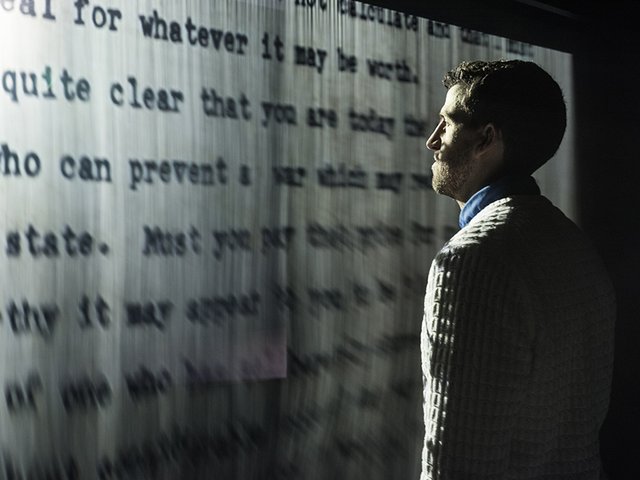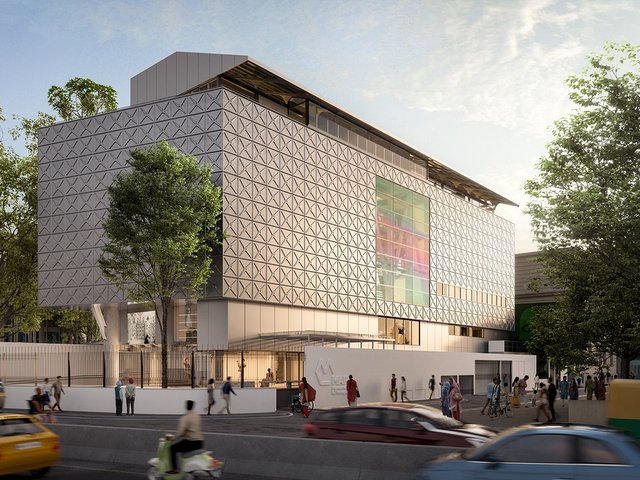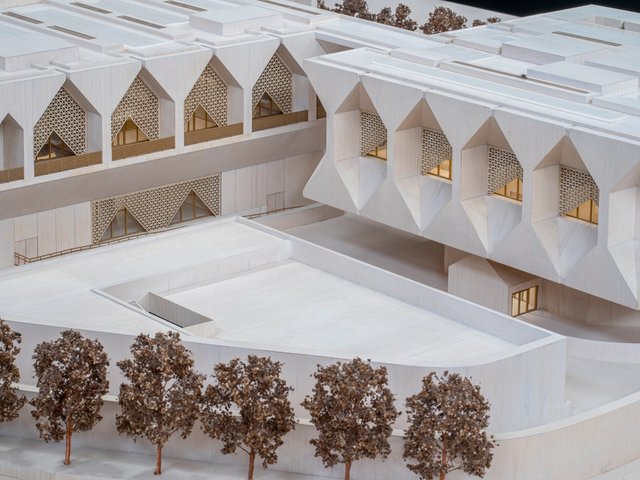India’s leading private museum of Modern and contemporary art, the Kiran Nadar Museum of Art (KNMA) in Delhi, has been embroiled in a controversy since early July following the termination of its manager of curatorial research and publications, Sandip K Luis.
Luis was terminated over a Facebook post in which he expressed critical views against a state-organised exhibition held in the National Gallery of Modern Art (NGMA) in New Delhi. Jan Shakti was organised by India's Ministry of Culture in collaboration with the NGMA to celebrate the 100th episode of a radio show hosted by India’s prime minister, whose right-wing and Hindu nationalist policies have proved highly polarising.
Among other aspects of the show, Luis criticised the complicity of its participating artists, curators and the patron Kiran Nadar in instrumentalising contemporary art for government propaganda. Nadar, who served as an advisor to the exhibition, is India’s most prominent modern and contemporary art collector, and the founder and chairperson of the eponymous museum where Luis was an employee.
Since Luis’s termination, hundreds of people from the art and academic community around the world have expressed their support for him via social media platforms and a signature campaign demanding his reinstatement. Among the signatories are artists, scholars, curators, writers and students that include art historian and former dean of The School of Arts and Aesthetics in Jawaharlal Nehru University, Prof. Parul Dave Mukherjee, along with artist and former curator of the Kochi-Muziris Biennale, Anita Dube.
Luis's termination also prompted the prominent Bangladeshi photojournalist Shahidul Alam to pull his solo show at the KNMA—which was planned to open on 17 July—at the last minute. Speaking to the Indian Express, Alam voiced concern for "the clear endorsement by Nadar of art events which are part of the propaganda machinery of the current Indian regime, and the censure of people who make legitimate critiques of such associations".
A text by Luis detailing his version of the events can be read here.
The controversy has triggered a discussion in India that has been long overdue: a discussion on the accountability of private museums, and what it means for private entities running museums, foundations and institutions to be public. Is it merely about being open to the public? Or is it also about being answerable to the public? While Luis's termination pertains to a Delhi museum, its ramifications bear relevance to private museums around the world.
Being realistic
While Luis's termination has provoked outrage from across the cultural community, there has also been a groundswell of support in defence of Nadar and the museum, especially among India’s leading gallerists. Peter Nagy, the founder of Nature Morte gallery in Delhi, wrote in an Instagram post earlier this month that "no one has done more to support the progressive and serious art forms of India in the past decade" than Nadar.
While the extent of this superlative could be argued, it is undeniable that both Nadar and her institution have played a highly central role in the recent history of Indian art. Not only is the KNMA open to the public free of charge, it has supported a considerable number of cultural initiatives in India and overseas, commissioned artists to produce new works and supported the travel of exhibitions internationally. It also collects a great deal of work, financially supporting a contemporary art ecosystem in which there are few serious patrons and virtually no state support.
The emphasis on the importance of private museums has been systematically institutionalised in the last two decades in India, as well as other parts of the world. It has developed from a structural transformation of the field, where the art market has been positioned as the only system that can sustain art and artists. This logic dictates that without art collectors there would be no art market; without an art market there would be no galleries and art fairs; without galleries and fairs the artists could not create, show and sell their work. Effectively, without private collectors there would be no art.
Underlying the view that collectors and the art market are the key benefactors for the arts is that there is no other alternative. The cultural theorist Mark Fisher famously described this condition as 'Capitalist Realism’, where people are persuaded to believe that there is no alternative to capitalism and neoliberalism. It is no coincidence that over the past two decades, commercial art galleries and art fairs have been pivotal for discourse, publications, curatorial opportunities, grants and art production.
The specific intersection we find ourselves at in the private museum landscape of India, and the world over, is one in which neoliberal corporatisation meets with neo-feudalism—a "Feudo-Capitalism". It is directly linked to individuals (and families) owning enormous assets, especially in real-estate and other kinds of property holdings that are purposed as infrastructure for the public.
At a global level, the political economist Michel Lub Bellemare has compiled 15 years of research on what he describes as a rise of "Techno-Feudalist-Capitalism". More recently, the economist Yanis Varoufakis has written about "Techno-Feudalism", identifying a new economic model where big-tech entrepreneurs own entire platforms and cloud servers that become "public squares". It’s not what you consume, but where you consume, and whether you have any choice in the latter. In the context of private museums and foundations run by single individuals or a family, this offers a clue into what lies underneath the widespread consensus that there is no alternative to the private museum. What appears as the only realistic choice that the field has for sustaining, also becomes an altruistic act on the part of a benefactor.
Keeping Things Private
What then does it mean for privately run museums, foundations and institutions to be open to the public? A majority of them imply that their doors are open to visitors, and the idea of a public is merely one of an audience. Open to accountability, whether to the public, to the staff, or to the art community is out of the question. And why would it be any other way, when the raison d’être for the private museum is a favour being done to society? In a Feudo-Capitalist fantasy, patronage can very quickly become patronising.
Where does such a belief come from, and how does it get legitimised? For one, a non-profit status in the arts seems automatically to morally elevate a person or entity away from the necessary evil that is the art market. According to Feudo-Capitalism, art operates along a two-dimensional graph where the art market is on one axis, and philanthropy on the other. Based on this diagram, art belongs somewhere along a vertical and horizontal axis (you decide which one is which), of being a luxury commodity and a charitable cause. We know that art markets are always finding ways to reduce complex practices into simplistic commodities, best exemplified in art fairs.
But since when did contemporary art also turn into a charitable cause that requires support without which it would die? In the 19th and 20th centuries, journalism, academia, activism, and the arts, have all been hallmarks of independent thought. They have tested new ideas, formed new vocabularies and offered new imaginations for social and political life.
The inception of non-government organisations (NGOs) and non-profits was a way to advance independent thought, protecting it from instrumentalisation in the hands of government as well as corporate interests. With policies that offer tax wavers and make Corporate Social Responsibility (CSR) mandatory on large businesses, the non-profit becomes a fixed deposit.
In India, there are examples of private art museums that opened to the public, supported contemporary art, and closed down. Subsequently works from those collections return to the market, reified in their importance by virtue of having been connected to a museum. One is tempted then to regard the private museum as no different from an investment, except the returns are measured on an extended timeline as opposed to the immediate returns on short-term, high-risk investments.
This applies just as well to privately owned museums and foundations elsewhere in the world. The protracted return of investment (ROI) for private museums can be a couple of generations, but it is still a private asset accruing enormous value, that can be withdrawn from public view at will with no accountability.
We have not even touched on the symbolic capital that is accrued by patrons as they get invited on international museum boards and committees, with access to exclusive collector’s circles and so on. The art historian Santhosh Sadanandan observed the rise of this phenomena in the 2007 essay Perhaps (nothing is) Beyond Credos. Drawing from theories of the sociologist Pierre Bourdieu, he notes that art’s "transactions are defined by an aversion to the 'commercial'; it conceals from itself and others the interest at stake in its practice and establishes the means of deriving profit from disinterestedness… its effectiveness is defined by its ability to conceal its capital interest (the profit) and converts it into the symbolic capital".
When it comes to privately owned non-profits, there is a similar morality at work. A pattern of promotional exploitation becomes widespread on the pretext of limited funds. Artists are often asked to take less or no fee because of the promotion they will receive. The curator and researcher in turn become administrators of the enterprise, providing it critical legitimacy, at best with the promise to change the system from within, and at worst to be made to feel party to a system with no place for questioning as they have been coerced into it. Luis’s recent post short-circuited this loop. It opened the doors for the public, the staff, and the artistic community to lay a claim on the private museum, ask questions of it, and ask for accountability, as a museum truly open to the public.
Becoming Public
Between 1970-1971, the magazine Vrishchik founded and edited by the artists Gulammohammed Sheikh and Bhupen Khakhar ran a series of issues dedicated to artists protesting against the Lalit Kala Akademi (The National Art Academy) and the India Triennale. The magazine became the forum for debates and letters, both for and against the public institution. Many of the protest meetings took place inside institution’s premise. Many artists voicing their thoughts are today among the most celebrated names and their works are in public and private collections around the world. For a moment, what if we were to imagine that the ongoing discussion around KNMA’s controversy could also take place inside the museum, as part of the museum’s ethos rather than a scandal that threatens the museum’s image?
In her book Museums and Wealth: The Politics of Contemporary Art Collections (2022), Nizan Shaked offers insights into the fault-lines of the public-private museum. She points out that several museums around the world are private from a legal perspective, but can be regarded as public because they are subsidised by the government and can therefore be made publicly accountable, as it is the tax payers money enabling their subsidy.
Private museums, trusts and organisations in India established under Corporate Social Responsibility (CSR) laws are essentially running on the profits of companies that would have been taxable, but are channelled towards public benefit. Here too, the public can claim a right. The controversy surrounding the KNMA started from such a claim, to talk about a public exhibition hosted by a public institution—the National Gallery of Modern Art. The ensuing debate is a testament to the public life of all museums. It is also a testament to the public life of art, which is not based on loyalty to benefactors, but to keep alive the difficult question of what is valuable to society.
It can be argued that the public discourse of contemporary art in India has gradually narrowed in recent years, despite the boom in the art market, the rise of galleries, fairs, museums and biennials. The wider public perception regards art as a luxury industry, accounting for why most newspaper coverage on art is about auction records. Universities tend to bracket the diversity of the art field within the homogeneity of the art market, maintaining a critical distance from both.
The art market tries to maintain that art belongs to a niche section of society. Despite all its good intentions, the KNMA seems to have fallen victim to this fallow understanding of the narrowing perception of art, while the art field on the other hand, is churning as a site for production, experimentation, discussion and refuge. The present unrest in the past month seems to be asking, what is the public life of art that the artworld aspires to have? And, what is idea of ‘public’ that we wish to keep alive when we think of an institution open to public?
Museums are public institutions that emerge from a long history of social and political convulsions. Debates about what is of value to society go hand in hand with who gets to decide. This includes public discourse in the press about what should or should not be collected and shown in public museums. When something is done for the public good, expect there to be a public debate about whether the public finds it in its interest or not.
For museums receiving public subsidy, that question becomes all the more pressing as it is the tax payer’s money. For any private collector or organisation that wants to become a museum, they are not entering a history of becoming glorious. They are entering a history of becoming public, and the upheavals that come with it. A museum is a site of convulsions.
In writing a critical text about Jan Shakti, Sandip and subsequently the signatories of the campaign have in fact conferred upon the private museum a recognition of a public institution. This recognition comes because of the hard work and the intellectual and affective labour of several people who have built the museum since its inception.
Imagine if a commercial gallery in Delhi suddenly rebranded itself as a museum, would the field take it seriously? No. It takes years of hard work for a private entity to be regarded as a museum, and this in turn brings with it a set of responsibilities. The question now is, can the Kiran Nadar Museum of Art, or any private museum and foundation for that matter, stand up to what it claims to be: open to the public? While we should expect a private museum that claims to be open to the public to also be answerable to its public, I do not consider them as a solution to all the problems outlined in this text. A space for independent, critical and exploratory thinking is the least that the field expects from art spaces. A public private institution has that potential, to nurture the public life of art.





